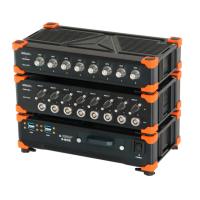Advanced Topics
8.2.2 Sync options
When you have several measurement systems, each of those systems has it's own internal clock (e.g. 2 SIRIUS®
systems). Since no real-world hardware is perfect the 2 clocks will run at slightly different speeds and thus will drift
more and more apart from each other.
Hardware synchronisation
The best way to synchronise the clocks of several devices is to use some sort of hardware synchronisation (e.g. a
synchronisation cable) that transmits a signal that can be used by the devices to synchronise their clocks to each other.
You can synchronise SIRIUS® systems to each other or also to other devices (e.g. DEWE-43, DS-NET).
Note that the hardware synchronisation function is not related in any way to the setting of the clockmaster.
No synchronisation
If you use no synchronisation at all the time shift between
the signals of the 2 devices will become bigger and bigger
the longer the measurement takes.
At the beginning of the measurement the 2 signals will be
very good aligned. In Illustration 223 you can only see
one of the signals, because the second one is exactly the
same and thus hidden behind the red one.
Illustration 223: No sync: start of measurement
After some time (depending on the relative clock drift of
the 2 devices), you will see that the signals are not
perfectly aligned any more...
...and the longer the measurement takes, the worse the
offset will become.
Illustration 224: No sync: small offset
Illustration 225: No sync: big offset
Doc-Version: 1.4.2 www.dewesoft.com Page 153/166

